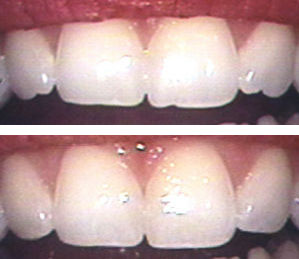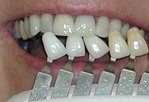
Bonding
Bonding is simply adding a little tooth-colored composite material to “fill in the blanks.” One of the most frequent uses of the bonding technique is to fill in a gap between front teeth.
Show allBonding is simply adding a little tooth-colored composite material to “fill in the blanks.” One of the most frequent uses of the bonding technique is to fill in a gap between front teeth.
Before: A noticeable space between the front teeth.
After: Bonding fills the space, but still keeps the teeth looking natural.
Show less

Bridges
A Permanent Bridge replaces one or more missing teeth. A Bridge will:
- Keep teeth from drifting into the space created from a missing tooth
- Make teeth easier to clean, thus helping to prevent gum disease
- Help preserve normal function and normal bite for the jaw joint
A Permanent Bridge is usually anchored to the teeth on both sides of the space from the missing tooth. This gives the bridge strong support. Brushing a bridge is no different than brushing natural teeth, but special flossing instructions are given to keep the bridge and surrounding tissue healthy.
Show allA Permanent Bridge replaces one or more missing teeth. A Bridge will:
- Keep teeth from drifting into the space created from a missing tooth
- Make teeth easier to clean, thus helping to prevent gum disease
- Help preserve normal function and normal bite for the jaw joint
A Permanent Bridge is usually anchored to the teeth on both sides of the space from the missing tooth. This gives the bridge strong support. Brushing a bridge is no different than brushing natural teeth, but special flossing instructions are given to keep the bridge and surrounding tissue healthy.
A Permanent Bridge is permanently bonded in place, unlike a Partial Denture (sometimes called a “Removable Bridge”), which is removable.
Show less
Enamel Shaping
Enamel Shaping (Contouring) is the process of shaping natural teeth to improve their appearance. Shaping can be used to correct minor cases of crowded or overlapping teeth, smooth rough edges, or make small adjustments to the shape of a tooth.
Show allEnamel Shaping (Contouring) is the process of shaping natural teeth to improve their appearance. Shaping can be used to correct minor cases of crowded or overlapping teeth, smooth rough edges, or make small adjustments to the shape of a tooth.
Before: This patient has a small notch in three of her four front teeth.
After: Minor contouring (shaping) of the enamel makes her teeth smooth and natural looking!
Show less

Teeth Whitening
Teeth Whitening is actually a mild whitening process that restores stained or discolored teeth to a healthy, natural color. Don’t be misled by unproven and ineffective over-the-counter whitening solutions. Our office uses an advanced procedure that is only available from your dentist.
Show allTeeth Whitening is actually a mild whitening process that restores stained or discolored teeth to a healthy, natural color. Don’t be misled by unproven and ineffective over-the-counter whitening solutions. Our office uses an advanced procedure that is only available from your dentist.
What Causes Tooth Discoloration?
Teeth become discolored for different reasons:
- Drinking coffee, tea, or colas.
- Some antibiotics may darken developing teeth in children.
- Aging – The dentin underneath the enamel of a tooth gradually darkens with age.
- Use of tobacco products.
- Accidents – If a tooth has been traumatized, sometimes the nerve will gradually “die”, and the tooth becomes dark.
- After Root Canal Therapy, a tooth will generally darken.
Is Whitening Safe?
Whitening is very safe. We use a product that has been proven safe when used under the direction of a dentist.
Is Whitening For Me?
Dr. Loar will evaluate your teeth and smile to determine whether whitening is right for you. In some cases a different cosmetic procedure may better meet your expectations, but whitening is a safe, fast and easy process that is effective for almost everyone!
We Give You Choices!
For In-Office whitening, we utilize the advanced LumaLite™ light-activated process. We also offer Life Like, Natural Elegance, and Day/White® take-home whitening that can be used instead of, or in conjunction with, in-office whitening.
What Is The At-Home Whitening Process?
First, we will make impressions of your teeth so that our lab can create custom whitening trays to fit your mouth. These trays will guide the whitening agent to the areas of your teeth that need to be bleached. We will record the current color of your teeth to help you monitor your progress.

Next, we will fit your custom trays in your mouth to ensure they feel comfortable. We will instruct you on how to apply the whitening agent to your trays and how to insert them into your mouth. You will take the custom trays and whitening agent home with you. Usually patients wear the whitening trays for 2 – 3 hours in the evening, but they may be worn during the day since the clear, custom-fitted trays are barely visible and do not interfere with your ability to speak. In cases where we are able to use the newer whitening products, you will only have wear the whitening trays for 20-30 minutes once or twice a day and for only 7-10 days.
When Will I See Results?
 Immediately! Most patients see results after the first night. It will typically take from 2 to 6 weeks to restore your teeth to a beautiful white. The time it takes depends on the original color of your teeth, how discolored they were, and how frequently the treatment is applied.
Immediately! Most patients see results after the first night. It will typically take from 2 to 6 weeks to restore your teeth to a beautiful white. The time it takes depends on the original color of your teeth, how discolored they were, and how frequently the treatment is applied.
How Long Will The Results Last?
The effects typically last several years. Many patients choose to “touch-up” their teeth every 6 to 12 months by applying the treatment once or twice. “Touch-ups” are especially useful for patients that drink beverages that stain teeth, like coffee, tea, and colas.
Are There Any Side-Effects?
Some patients may experience heightened tooth sensitivity to cold, or mild tooth or gum sensitivity during treatment, but these symptoms are only temporary and disappear within a few days.
Show less
Veneers
Veneers are laboratory fabricated, porcelain facings that are bonded to the front surfaces of teeth to whiten teeth, close spaces, straighten teeth, or repair chipped or worn teeth. The veneers are only about 1 mm thick (the thickness of a fingernail). That same thickness is “shaved” off the natural tooth surface so when the veneer is bonded to the tooth, the tooth doesn’t feel or look “thicker”.
Show allVeneers are laboratory fabricated, porcelain facings that are bonded to the front surfaces of teeth to whiten teeth, close spaces, straighten teeth, or repair chipped or worn teeth. The veneers are only about 1 mm thick (the thickness of a fingernail). That same thickness is “shaved” off the natural tooth surface so when the veneer is bonded to the tooth, the tooth doesn’t feel or look “thicker”.
Before: Discoloration on front teeth and teeth are uneven in length.
After: Veneers return the natural, healthy glow! Teeth are now lengthened evenly.
Show less


